81. Originally
(around 4700 BC)
the Gemini twins
(Punarvasu)
were rising with
the Sun at the
northern spring
equinox:
... In Hindu
legend there was
a mother goddess
called Aditi,
who had seven
offspring. She
is called
'Mother of the
Gods'. Aditi,
whose name means
'free,
unbounded,
infinity' was
assigned in the
ancient lists of
constellations
as the regent of
the asterism
Punarvasu.
Punarvasu
is dual in form
and means 'The
Doublegood
Pair'. The
singular form of
this noun is
used to refer to
the star Pollux.
It is not
difficult to
surmise that the
other member of
the Doublegood
Pair was Castor
...
... According to
Manuscript E the
basic change was
from a sea
journey to
landfall. At the
time of
rongorongo the
stars came a
quarter later
than when the
current
constellations
had been defined
- with the
northern spring
equinox where
the Sun went
from Castor (who
ruled the winter
waters) to
Pollux (who
brought daylight
and dried up the
land). 26000
years (the
anciently
adopted duration
for the
precessional
cycle) *
¼ = 6500 = 1842
AD + 4658 BC,
when the left
foot of Castor
had been close
to the rising
Sun at 0h
...

... If the
Egyptians had had a background of many millennia to
reckon with, who, he asked, could have been unaware of
the Precession? The very sweepers of their observatories
would have known ...
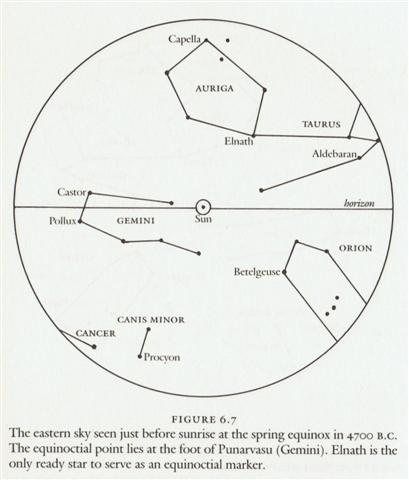
|
MAY
8 (2 * 64) |
9 |
10
(130) |
11 |
12 |
13
(*53) |
 |
 |
 |
 |
 |
 |
|
Ga2-18 (2 * 24) |
Ga2-19 |
Ga2-20 (130 - 80) |
Ga2-21 |
Ga2-22 |
Ga2-23 |
|
Ghost-23 (?)
ρ
Gemini (?) (112.1),
Eskimo Nebula = NGC2392 Gemini
(112.2) |
Al
Dhirā'-5 (Forearm)
/
Punarvasu-7 /
Mash-mashu-Mahrū-10 (Western One of the
Twins)
CASTOR
= α Gemini
(113.4) |
ANA-TAHUA-VAHINE-O-TOA-TE-MANAVA-7
(Pillar for elocution)
υ
Gemini (114.0),
MARKAB (Κ in
ARGO NAVIS)
(114.7), ο Gemini (114.8),
PROCYON
= α Canis Minoris
(114.9) |
α
Monocerotis
(115.4), σ Gemini (115.7) |
Mash-mashu-arkū-11 (Eastern One of the
Twins)
κ
Gemini (116.1),
POLLUX
= β Gemini
(116.2), π Gemini (116.9) |
AZMIDISKE (Ξ
in ARGO NAVIS)
(117.4) |
|
July 11 |
12
(193) |
13 |
14
(*115) |
15 |
16 |
|
°July 7 |
8 |
9 |
10
(*111) |
11 |
12
(193) |
|
'June 14 |
15 |
16 |
17
(*88) |
18 |
19
(*90) |
|
"May
31 |
Maro 1 (152) |
2 |
3 |
4 |
5
(*76 = *53 + 23) |
|
Egyptian hand |
 |
Phoenician kaph |
 |
Greek
kappa |
Κ (κ) |
|
Kaph is thought to have been
derived from a pictogram of a hand
(in both modern Arabic and modern
Hebrew, kaph means palm/grip)
...
... The manik, with the
tzab, or serpent's rattles as
prefix, runs across Madrid tz. 22 ,
the figures in the pictures all
holding the rattle; it runs across
the hunting scenes of Madrid tz. 61,
62, and finally appears in all four
clauses of tz. 175, the so-called
'baptism' tzolkin. It seems
impossible, with all this, to avoid
assigning the value of grasping or
receiving. But in the final
confirmation, we have the direct
evidence of the signs for East and
West. For the East we have the glyph
Ahau-Kin, the Lord Sun, the
Lord of Day; for the West we have
Manik-Kin, exactly corresponding
to the term Chikin, the
biting or eating of the Sun, seizing
it in the mouth.

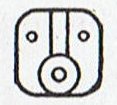

The
pictures (from Gates) show east,
north, west, and south; respectively
(the lower two glyphs) 'Lord' (Ahau)
and 'grasp' (Manik).
Manik was the 7th day sign of
the 20 and Ahau the last
... |
|
|
MAY 14 |
15 (500 = 135 + 365) |
16 (136 = 408 / 3) |
17 (402 - 265) |
18
Hanga Te Pau |
19 (*59) |
|
Nga
Kope Ririva Tutuu Vai A Te Taanga
(=
Ξ, Χ, Ζ in ARGO NAVIS?) |
 |
 |
 |
 |
 |
 |
|
Ga2-24 |
Ga2-25 |
Ga2-26 |
Ga2-27
(π) |
Ga2-28 |
Ga2-29 (59) |
|
φ Gemini
(118.4) |
DRUS (Χ
in ARGO NAVIS)
(119.9) |
ω Cancri
(120.2) |
8h (121.7)
χ Gemini
(121.0),
NAOS
(Ζ in ARGO NAVIS)
(121.3) |
Ρ in
ARGO NAVIS
(122.0),
HEAP OF FUEL
= μ Cancri
(122.1), ζ Monocerotis (122.3), ψ Cancri
(122.6),
REGOR
(Γ in ARGO NAVIS)
(122.7) |
TEGMINE
= ζ Cancri
(123.3) |
|
July 17 |
18 |
19 (200) |
20 (*121 = 11 * 11) |
21 |
22 / 7 |
|
°July 13 |
14 |
15 (196) |
16 |
17 (*118 = 4 * 29½) |
18 |
|
'June 20 |
SOLSTICE |
(200 - 27 = 159 + 14) |
23 |
ST JOHN'S
DAY |
25 (*96) |
|
"June 6 |
7 |
8 |
9 (160) |
Maro 10 |
11 |
|
... Midsummer is the flowering season of the
oak, which is the tree of endurance and
triumph, and like the ash is said to 'court
the lightning flash'. Its roots are believed
to extend as deep underground as its
branches rise in the air - Virgil mentions
this - which makes it emblematic of a god
whose law runs both in Heaven and in the
Underworld ... The month,
which takes its name from Juppiter the
oak-god, begins on June 10th and ends of
July 7th. Midway comes St. John's Day, June
24th, the day on which the oak-king was
sacrificially burned alive. The Celtic year
was divided into two halves with the second
half beginning in July, apparently after a
seven-day wake, or funeral feast, in the
oak-king's honour ... |
|
...
It is known that the Polynesians navigated by
the stars. It is therefore not surprising that
names of stars are directly and indirectly
contained in some of the place names on the
list. In two cases, there is direct agreement
with the names of stars used by the Easter
Islanders: compare he kope riva with name
1. nga kope ririva ... and Te Pou
(Sirius, alpha in Canis Major) with name 8.
te pou (Barthel 1962b:2)
... |
|
...
On the twenty-fifth day of the first month (Vaitu
Nui), Ira and Makoi set sail;
on the first day of June (Maro), the bow
of Ira's canoe touched land again.
Ira's
canoe appeared on the distant horizon, came
closer on its course, and sailed along, and
finally (one) could see the (new home) land. The
canoe reached the islets (off the coast), and
Ira saw that there were three such islets.
Ira said, 'Hey you, crew of young men, the
vision of Hau Maka, our father, which he
revealed to me, has come true. There are the
handsome sons of Te Taanga, who are
standing in the water, for this is the name that
the dream soul of Hau Maka gave them.
Unforgotten (? kai viri kai viri) are
they, these three. And therefore this is the
(right) land lying there; this is Te Pito O
Te Kainga, which also received its name from
the dream soul.'
He
ui a Ira.ko te motu etoru.he ki a Ira.he ro
korua e kau a repa e ku ketu ana te urunga.a Hau
maka o to tatou matua.i hakahi mai ai kia au.ko
nga kope ririva tutuu vai a te taanga.te ingoa o
te motu ena etoru i nape ai e te kuhane o Hau
maka.
Ira saw that there were three such islets.
(E:17)
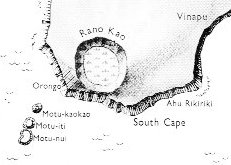
Makoi named the place Hanga Te Pau,
'the landing site of Ira'. So that
they would remember (? he aringa,
literally, 'as face'), the open side of
Hanga Te Pau was given this name. Ira
got up. They all climbed to the top of the
hill. They climbed up on the tenth day of
the month of June 'Maro'. |
|
.jpg) |
|
...
Gamma Velorum (γ
Vel, γ
Velorum) is a star system in the constellation
Vela. At magnitude +1.7, it is one of the
brightest stars in the night sky. It has the
traditional names Suhail and Suhail al
Muhlif, which confusingly also apply to
Lambda Velorum. It also has a more modern
popular name Regor, which was invented as
a practical joke by the Apollo 1 astronaut Gus
Grissom for his fellow astronaut Roger Chaffee.
Due to the exotic nature of its spectrum (bright
emission lines in lieu of dark absorption lines)
it is also dubbed the 'Spectral Gem of Southern
Skies' ... |
It strikes me
that by the
effects of the
precession it
should have
been necessary
to expand the
calendar
structure in
order to cover
the journey of
the Sun not only
anciently but
also in current
time (and
furthermore even
in several time
frames in
between). 471
(glyphs in the G
text) = 1½ *
314.
And
the 'double-good
pair' (Punarvasu) could have
been named so
because one of
them ruled
one half of the
Sun cycle and
the other twin
the other half -
with each of
these 'years'
(halfyears)
divided in 2
because at
zenith the sky
dome was divided
into a pair (of
quarters).
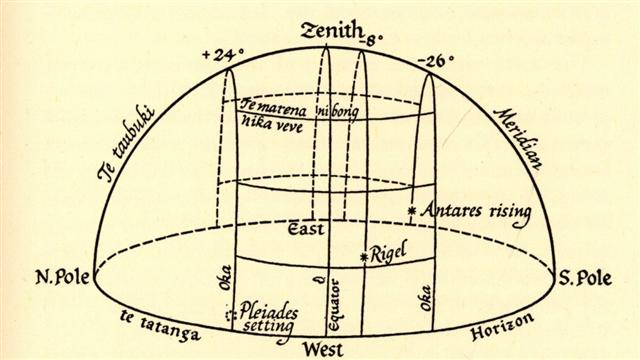
|
time of rongorongo |
37 |
time of Bharani |
 |
 |
 |
 |
 |
 |
|
Cb7-11 (155) |
Cb7-12 |
Cb7-13 (314 / 2) |
Cb8-24 (195) |
Cb8-25 (392 / 2) |
Cb8-26 |
|
March 20 (79) |
SIRRAH (*0) |
22 |
"March 19 (78) |
20 |
BHARANI (*41.4) |
The glyph type
maitaki
(good) could then
be explained as
marking spring
equinox at any
time frame, a
reuse of the
original meaning of the
double-good
Gemini pair.
There is only
one example in
the C text of a
'triple-good'
maitaki
and it follows
immediately
after the Gemini
pair:
 |
 |
 |
 |
| Ca5-5 |
Ca5-6 |
Ca5-7 |
Ca5-8 (113) |
| kua iri i te rakau |
ihe tamaiti |
erua mago |
| |
|
|
CASTOR (*113) |
| "May 29 |
30 |
31 (151) |
Maro 1 |
| ALRAMI = α Sagittarii |
|
(*295 = *112 + 183) |
|
 |
 |
 |
| Ca5-9 |
Ca5-10 |
Ca5-11 (116) |
| te hokohuki erua |
te marama |
| |
|
POLLUX (*116) |
| "June 2 |
3 |
4 (155 = 196 - 41) |
| SHAM (Arrow) = α Sagittae |
(*298 = *115 + 183) |
TARAZED = γ Aquilae |
 |
 |
 |
 |
 |
| Ca5-12 |
Ca5-13 (118) |
Ca5-14 |
Ca5-15 |
Ca5-16 (121) |
| te maitaki |
te henua |
kua haga te mea ke |
manu puoko i tona ahi |
kua heu te huki |
|
Nga
Kope Ririva Tutuu Vai A Te Taanga (= Ξ, Χ, Ζ in ARGO NAVIS?) |
| AZMIDISKE (ξ) |
φ Gemini (*118) |
DRUS (χ) |
ω Cancri |
NAOS (ζ) |
| INVISIBLY CLOSE TO THE SUN (helical dates): |
| July 16
'June 19
"June 5
MAY 13 (5-13) |
17
20 (*91)
6 (157 = 471 / 3)
14 |
18
SOLSTICE
7
(500 = 135 + 365) |
19 (200)
22 (173)
8 (*79)
16 (136) |
20 (*121)
23
9
17 (*57) |
| CLOSE TO THE FULL MOON (and nakshatra dates): |
| ALTAIR (*300) |
φ Aquilae |
|
τ Aquilae |
|
| January 15
'December 19
NOVEMBER 12 |
16
20
13 |
17
SOLSTICE
14 |
18
22
15 |
19 (384)
23 (357)
16 (320) |
... What then was the basic meaning of maitaki with 3 'eyes' in contrast to maitaki with 2 mata? I guess solstice in contrast to equinox:
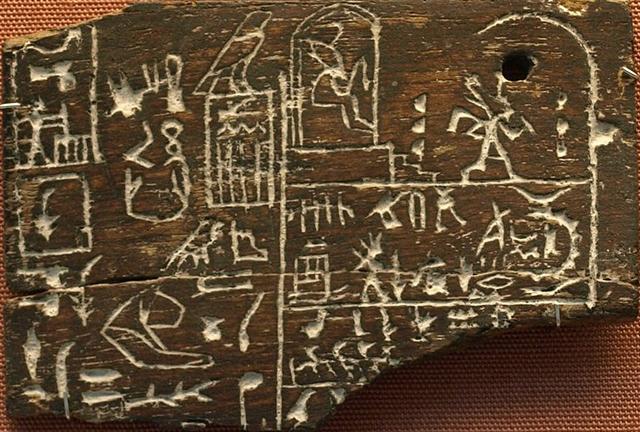
... Ebony label EA 32650 from Den's tomb. The upper right register depicts king Den twice: at the left he is sitting in his Hebsed pavilion, at the right he is running a symbolic race around D-shaped markings. This ceremony is connected to the so-called 'race of the Apis bull'. The middle right section reports about the raid of the city 'beautiful door' and about a daughter of Den suffering from an unknown disease. The lower right section reports about the visitation of the 'souls of Peh' at the royal domain 'Wenet'. The left part of the label describes the content of the vessel that once belonged to the label and mentions the high official Hemaka [cfr Hau Maka], who was obviously responsible for the delivery of the labeled jar ...
... Ebony is a dense black wood, most commonly yielded by several different species in the genus Diospyros. Ebony is dense enough to sink in water ...
Antares was drawn as a shark (mago) with curved tail and his arrival together with the Sun was a good thing, because it meant the southern summer had arrived. A pair of sharks (erua mago) could then possibly be understood as doubly good (Ca5-7--8). Therefore it
could have been suitable for the Explorers to reach Easter Island when the Sun reached Castor in "June 1 (Maro 1). And half a year later, when they left Easter Island, the proper type of glyph
should indicate the opposite -
twice bad (bad, bad) = inoino.
Or to be more
precise, there
should be a pair
of such glyphs,
a 'double-bad'
pair (erua
inoino):
 |
 |
 |
| Ca10-1 (256) |
Ca10-2 |
Ca10-3 |
| Erua inoino |
kua hua te vai |
| VISIBLE CLOSE TO THE FULL MOON: |
| HASSALEH (ι Aurigae) |
HAEDUS I (ζ) |
HAEDUS II (η) |
 |
 |
 |
 |
| Ca10-4 |
Ca10-5 (260) |
Ca10-6 |
Ca10-7 |
| te kiore - te inoino |
kua oho te rima kua kai - ihe nuku hoi |
Tupu te toromiro |
kua noho te vai |
| Tangaroa Uri 25 |
"October 26 |
27 (300) |
28 |
| VISIBLE CLOSE TO THE FULL MOON: |
| Vaitu Nui 25 |
"April 26 |
27 (117 = 300 - 183) |
28 |
| CURSA (β Eridani) |
μ AURIGAE, μ Leporis |
RIGEL, CAPELLA |
λ AURIGAE, λ Leporis |
| Kino 1. Bad; kikino, very bad, cursed; kona kino, dangerous place. 2. blemish (on body). Kinoga, badness, evil, wickedness; penis. Kinokino, badly made, crude: ahu kinokino, badly made ahu, with coarse, ill-fitting stones. Vanaga.
1. Bad, wrong. T Pau.: kiro, bad, miserable. Mgv.: kino, to sin, to do evil. Mq.: ino, bad, abominable, indecent. Ta.: ino, iino, bad, evil; kinoga (kino 1) sin; Mgv.: kinoga, sin, vice. 2. A skin eruption, verruga, blotched skin, cracked feet T. Churchill. |
 |
 |
| maitaki |
inoino |
| very good |
very bad |
When Altair (the old eagle) was visible close to the Full Moon it meant the Sun had reached Azmidiske -
at the 'tent pole' in Argo Navis far down in the south. The Explorers had successfully followed the directions of the dream soul of Hau Maka and traversed the sea to reach land. Very good. When they left
in Tangaroa Uri 25
(i.e. 288 - 152
= 146 = 2 * 73 = 2 / 5 * 365 days later) the dangerous sea was ahead, very bad.
|
Dates according to Manuscript E -
the Explorers: |
|
Departure |
Sea voyage |
Arrival |
|
Vaitu
Nui 25 (115)
"April 25 (115,
*35) |
152 - 115 = 37 days |
Maro 1 (152)
°June 1 (152, *72) |
|
CURSA (*35) |
(*72 - *35) - (41 - 4) = 0 |
CURSA (*72) |
|
°June 1 (152, *72)
CURSA (*72) |
189 - 152 =
37 days |
°July 8 (189,
*109)
CASTOR (*109) |
|
Return in
Tangaroa Uri
25 = "October 25 (298,
*218) |
ANTARES (*249 = *218 + 41) |
|
37 (Sea) + 146 (Land) =
183 (= 366 / 2) |

|









.jpg)







